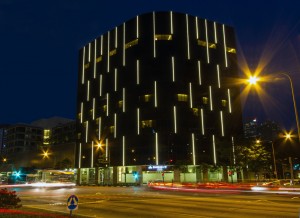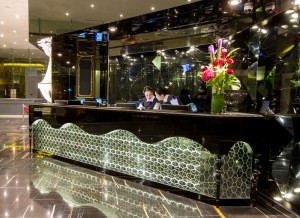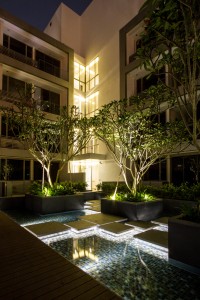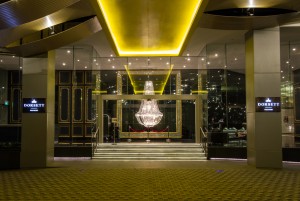The Business Times: Lighting the Way
Friday April 5th, 2013 In the News
URL: http://www.businesstimes.com.sg/specials/property/lighting-way-20130405
Given rising energy costs and improvements in technology, LED lighting has become an increasingly attractive option for new buildings
“LED lights are more energy-efficient because most of the power going into them is converted into light.”

All powered up: The hotel’s façade is lit by LED lighting.
AS the use of energy-efficient lights becomes more widespread, new hospitality player Dorsett Hotel and Residences stakes its claim to being South-east Asia’s first new-built hotel with more than 95 per cent LED lights.
Much has been said about the advantages these energy-efficient lights offer over conventional incandescent, fluorescent and halogen ones, but property developers with an eye on the bottom line baulk at the high upfront costs of installing them, convinced that their costs outweigh their long-term benefits.
But LED lighting has become an increasingly attractive option for new buildings, given rising energy costs and improvements in LED technology, which have made them cheaper.
The Building and Construction Authority’s (BCA) Green Mark Scheme, which sets up benchmarks for the construction industry to shoot for at the designing stage for buildings, is also providing a nudge towards the adoption of greener forms of lighting. Buildings which have earned the Green Mark burnish their companies’ corporate image and boost their leasing and resale value.
The management of Dorsett Hotel and Residences was swayed by these considerations, said Ecolight Design Consultants, the lighting consultancy engaged for the project.Owned and managed by Hong Kong-based hospitality group Dorsett Hospitality International, formerly known as Kosmopolito Hotels International, the property comprises the 10-storey Dorsett Singapore – the group’s first hotel in Singapore – and a six-storey residential block, both in New Bridge Road.

All powered up: The hotel’s reception counter illuminated with LED lights.
The hotel’s general manager Philip Wong said that rising energy costs were the main reason behind the hotel’s move to use energy-efficient lighting. Air-conditioning typically accounts for 60 per cent of a building’s energy consumption, and lighting, 30 per cent.
For Dorsett Hospitality, the fact that the decision was taken at the design stage to use energy-efficient lighting made the cost less prohibitive than it would have been to retrofit an existing building.
Mr Wong declined to disclose the sum spent on lighting the hotel, but said that he believed the investment to be worth the money: “We have made our projections and believe that the overall savings from the operating costs of the property far outweigh any initial upfront cost of implementing energy-efficient technologies.”
Ong Wei Ping, the executive director of Ecolight Design Consultants, estimates that the lights are expected to use 45 per cent less power than conventional incandescent lights.
The reduction in energy use is a result of the increased efficacy of energy-efficient lights; they use a smaller wattage to achieve an equivalent “lux” – a unit of illumination – level of lighting, he said. LED lights are more energy-efficient simply because most of the power going into them is converted into light; conventional incandescent, halogen and fluorescent lights, on the other hand, use most of the power to heat up their filaments.
And their being warmer sources of light makes buildings’ air conditioning work harder, which adds to overall energy consumption.

Bright idea: The hotel’s reflection pond illuminated with LED lights.
ANOTHER advantage of LED lights is their longer life span. Mr Ong estimates that LED lights can last more than 50,000 hours, depending on the quality of the lamp and ambient conditions. With LED lights left on round the clock, building owners may be able to recoup their upfront costs in under a year, he said.
To run up even more savings, the Dorsett Singapore has installed motion sensors in its emergency exits, so the lights there come on only when these areas are used.
Dorsett Singapore has another “first”: It is also the first hotel in South-east Asia to use plasma lighting for its facade, said Mr Ong, whose consultancy is the sister company of IEQ Global, which works with two leading plasma brands to develop lighting applications for use here and across South-east Asia.
One of the most advanced energy-efficient lighting technologies in the market, plasma is an electrode-less light source powered by radio frequencies. Among its advantages are its powerful lighting and lumen density; in the case of Dorsett Singapore, just one 1,000-watt lamp throws light to heights beyond 50 storeys – and in colour to boot.
Mr Ong said that if the hotel had used conventional metal halides, it would have needed three to four of these to achieve a similar level of lighting; even then, the quality of illumination would not be the same. “Metal halides cover a small area and would have to be directed at intervals along the height of the building facade. Even then, the areas further from the metal halide light source will be dimmer than those nearer the source,” he said.
An all-LED hotel in future?

Bright idea: The hotel entrance lit by LED lights
Asked what stopped the Dorsett from being a 100 per cent LED hotel, Mr Ong said that it was because certain areas of the hotel had their own unique lighting requirements; the facade, for instance, uses plasma lighting.But as LED technology improves, the hotel has the option of switching the remaining lights to LED ones, he added.
Mr Ong, saying the benefits of going green go beyond the bottom line, added: “Utilising energy-efficient lighting can enhance the reputation of the property developer, by establishing the developer as being ahead of the sustainability curve.
“A lot of Singaporean buyers are now looking for projects that have green technology or a Green Mark rating,” he said, and noted that some Malaysian developers have taken to adopting the standards of the BCA Green Mark in their properties, and marketing them in Malaysia and here as a valued feature.